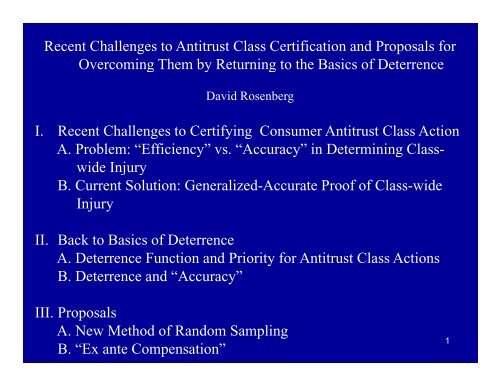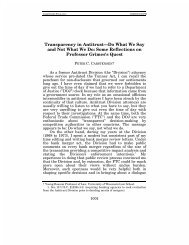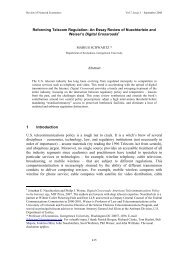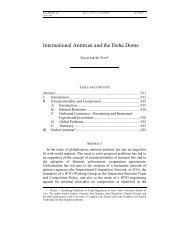Rosenberg Slides - American Antitrust Institute
Rosenberg Slides - American Antitrust Institute
Rosenberg Slides - American Antitrust Institute
You also want an ePaper? Increase the reach of your titles
YUMPU automatically turns print PDFs into web optimized ePapers that Google loves.
Recent Challenges to <strong>Antitrust</strong> Class Certification and Proposals forOvercoming Them by Returning to the Basics of DeterrenceDavid <strong>Rosenberg</strong>I. Recent Challenges to Certifying Consumer <strong>Antitrust</strong> Class ActionA. Problem: “Efficiency” vs. “Accuracy” in Determining Class-wide InjuryB. Current Solution: Generalized-Accurate Proof of Class-wideInjuryII. Back to Basics of DeterrenceA. Deterrence Function and Priority for <strong>Antitrust</strong> Class ActionsB. Deterrence and “Accuracy”III. ProposalsA. New Method of Random SamplingB. “Ex ante Compensation”1
I. Recent Challenges to Certifying Mass Consumer <strong>Antitrust</strong> ClassActionA. Core Concern: Efficiently Determining Class-wide (vs.aggregate) Liability “Accurately”B. Recent Focus: Determining Class-wide (vs. aggregate) Injury(“Loss Loss, ”“Causation”)2
C. Current Solution: Generalized-Accurate Proof Class-wide Injury1. Expensive Econometric Models and Applications2P 2. Pre-certification Review of “Accuracy” in Cases ofHeterogeneous Market Conditions and Effectsa. Combination of Summary Judgment and Daubertb. Full-scale Discovery3. Unreal Problem of Typicality and Adequacy of Representation4. Paradoxical Solution of Pre-certification Merits Review3
II. Back to Basics of DeterrenceA. Deterrence Function of <strong>Antitrust</strong> Class Action1. Enhance Scale Economiesa. Lower Litigation ii i Costb. Increase Litigation Quality2. Correct Asymmetry in Litigation Power3. Maximize Law Enforcement Efficiencies4
B. Deterrence Priority1. Optimal Deterrence: Maximize Deterrence Benefits byMinimizing Sum of Enforcement Costs (e.g., transaction costs + neterror costs) t)2. Prevent Rather Than Compensate Illegal Harm: MaximizesSocial Welfare If <strong>Antitrust</strong> Violation would Impose Expected SocialCost > Expected Private (Social) Benefit5
C. Deterrence and Accuracy1. Deterrence, Ex ante Perspective, and Incentive to Obey Lawa. Internalize Optimal Sanctionb. Expected Optimal Sanction > Expected Private Benefit ofIllegality2. Optimal Ex Post Sanctiona. Actualized Harm: Normally Optimal Sanction = ActualAggregate Harmb. Risk-based = Probability of Illegal Conduct x ActualAggregate Average Harm6
d. Example:1) Assume: Firm violates antitrust laws expecting privatebenefit = $500, and illegal social harm = 50-50 chance of $0/$1200(correlated expected loses respectively A = $0/$200 x 50%; B =$0/$400 x 50%; C = $0/$600 x 50%). Assume optimal sanction =$600.2) Actualize Aggregate Harm Sanction: state of the ex post world #1: $1200 aggregate socialharm = $1200 sanction, or state of the ex post world #2: $0 aggregate social harm ex ante, Firm internalizes es expected aggregate sanction =$600 ($1200 x 50% + $0 x 50%)3) Risk-based Sanction = Probability of Illegal Conduct xExpected Social Harm from Illegal Conduct = $600 ($1200 x 50%)7
III. ProposalsA. New Method of Random Sampling1. Description of the method:First step: The parties specify the number of claims for sampling;Second step: The court randomly selects the party-designed numberof claims from among the set of claims in question, each ofwhich is then resolved in the normal course by judgment orsettlement.Third step: The defendant’s d aggregate liability and damages aredetermined by the court employing either of two alternativeprocedures depending on whether the number of claims selectedwas one or more than one: single claim sampling (“SCS”) or8average claim sampling (“ACS”):
SCS: If one claim is randomly selected and resolved, the court appliesthe resulting outcome – that is, the amount (if any) the plaintiff therebyrecovers under judgment or settlement – as per force determinative ofthe outcome attributable to each and every claim against the defendant,selected ec ed and non-selected. ec ed. In essence the court derives the defendant’se d aggregate liability and damages by multiplying the recovery from thesampled claim by the number of claims in the group, orACS: If more than one claim is selected and resolved, the court derivesand applies the average of the resulting outcomes – that is, the averageof the amounts (if any) thereby recovered from settlement or judgmentby the plaintiffs on their respective claims – as perforce determinativeof the outcomes attributable to each and every claim against thedefendant, selected and non-selected. In essence the court derives thedefendant’s aggregate liability and damages by multiplying the averagerecovery from the sampled claims by the number of claims in thegroup.9
2. Example: Assume that Firm’s expected benefit from antitrustviolation = $500 and causes socially sanctionable harm to A = $100;B = $200; C = $300. Compare Firm’s (and class counsel’s)aggregate expected liability as determined claim-by-claim vs. newsampling method (SCS): claim-by-claim: Firm expects to pay total damages of$600 since this is sum of outcomes from resolving each claimseparately and individually$600: SCS: Firm expects to pay aggregate average damages of$100 (1/3 chance x $300 ($100 x 3)) +$200 (1/3 chance x $600 ($200 x 3)) +$300 (1/3 chance x $900 ($300 x 3))10
ACS alternative, random selection and resolution of two ofthe three claims would subject the defendant d to expected totalt damages of $600 = sum of averages of each of the 6 claimcombinations x 3 plaintiffs x 1/6 probability:1) A (100) + B (200)/2 = 150 x 3 = 450 x 1/6 = 752) B (200) + A (100)/2 = 150x3= 450x1/6= 753) A (100) + C (300)/2 = 200 x 3 = 600 x 1/6 = 1004) C (300) + A (100)/2 = 200 x 3 = 600 x 1/6 = 1005) B (200) + C (300)/2 = 250 x 3 = 750 x 1/6 = 1256) C (300) + B (200)/2 = 250 x 3 = 750 x 1/6 = 12511
B. “Ex ante Compensation”: Aggregate Class Recovery Net ofAttorney Fees and Costs Paid Over to Social Security1. Decoupling of Class Action Deterrence / CompensationFunctions2. Assuming Consumers are Risk Aversea. Maximize Insurance Value of Recoveryb. Individuals Prefer Certain Cash Payoff Ex ante to Gambleof Equal Expected Value (ignoring higher administrative cost)12
3. Assuming Consumers are Risk Neutral: “Behind the Veil”Perspectivea. Ex ante Compensation = Average Expected Loss from<strong>Antitrust</strong> Violationb. Negates Ex ante Expected Antirust Violation “Tax” onConsumers’ Choices re Consumption and Production13





